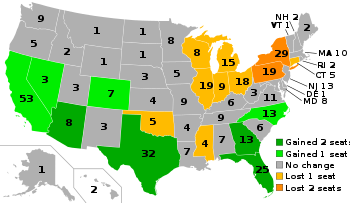



Congressional districts in the United States are electoral divisions for the purpose of electing members of the United States House of Representatives. The number of voting seats within the House of Representatives is currently set at 435, with each one representing an average of 761,169 people following the 2020 United States census.[1] The number of voting seats has applied since 1913, excluding a temporary increase to 437 after the admissions of Alaska and Hawaii. The total number of state members is capped by the Reapportionment Act of 1929.[2] In addition, each of the five inhabited U.S. territories and the federal district of Washington, D. C., sends a non-voting delegate to the House of Representatives.
The Bureau of the Census conducts a constitutionally mandated decennial census whose figures are used to determine the number of congressional districts to which each state is entitled, in a process called "apportionment". The 2022 elections were the first to be based on the congressional districts which were defined based on the 2020 United States census.[3]
Each state is responsible for the redistricting of districts within their state, while several states have one "at-large" division. Redistricting must take place if the number of members changes following a re-apportionment, or may take place at any other time if demographics represented in a district have changed substantially. Setting the boundaries of states' congressional districts is the responsibility of state governments, who often gerrymander districts for various reasons. Districts may sometimes retain the same boundaries, while changing their district numbers.
The following is a complete list of the 435 current congressional districts for the House of Representatives, and over 200 obsolete districts, and the six current and one obsolete non-voting delegations.
- ^ "2020 Census Apportionment Results Delivered to the President". US Census Bureau. April 26, 2021. Retrieved October 3, 2017.
- ^ Public Law 62-5 of 1911, though Congress has the authority to change that number.
- ^ Thompson, Don (October 12, 2022). "Census, term limit change means big turnover for lawmakers". APNews.com. Associated Press.